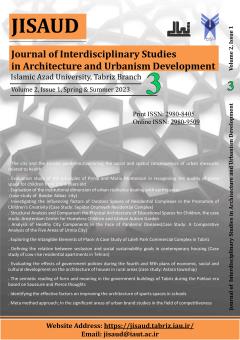The city and the corona pandemic; Examining the social and spatial consequences of urban measures related to health
Subject Areas :
1 - Ph.D in Urbansim and Researcher in Urbanism , Department of Architecture and Urban Studies (DAStU), Polytechnic University, Milan, Italy (Corresponding author) ketabollahi.kasra@gmail.com
Keywords: architecture, Urban Planning, COVID-19, Virtual world, social distancing,
Abstract :
The rapid spread of the Covid-19 disease has created a global public health crisis that has been addressed at various local and global scales through social distancing measures and guidelines. This is accompanied by questions about the nature of life and work patterns through the intensive use of information and telecommunication technologies, leading to social and institutional acceptance of these patterns as the "new normal".In terms of methodology, the discussion is based on a transdisciplinary framework that is used for conceptual analysis and operationalized by identifying and discussing the concepts of design and planning.This article emphasizes the following: a) Issues related to urban dynamics are drawn from the perspective of urban and human geography, urban design and planning, and transportation engineering. b) The questions related to socio-spatial concepts and the dialectic of urban space/urban life come from the field of environmental psychology.and c) discussions of new environments that accommodate new lifestyles/work go beyond ethnographic and anthropological perspectives. The article concludes with an outlook that outlines key aspects of the synergy needed between architectural and urban education, research and practice, and public health in a virtual and global post-pandemic world.The rapid spread of the Covid-19 disease has created a global public health crisis that has been addressed at various local and global scales through social distancing measures and guidelines. This is accompanied by questions about the nature of life and work patterns through the intensive use of information and telecommunication technologies, leading to social and institutional acceptance of these patterns as the "new normal".In terms of methodology, the discussion is based on a transdisciplinary framework that is used for conceptual analysis and operationalized by identifying and discussing the concepts of design and planning.This article emphasizes the following: a) Issues related to urban dynamics are drawn from the perspective of urban and human geography, urban design and planning, and transportation engineering. b) The questions related to socio-spatial concepts and the dialectic of urban space/urban life come from the field of environmental psychology.and c) discussions of new environments that accommodate new lifestyles/work go beyond ethnographic and anthropological perspectives. The article concludes with an outlook that outlines key aspects of the synergy needed between architectural and urban education, research and practice, and public health in a virtual and global post-pandemic world.The rapid spread of the Covid-19 disease has created a global public health crisis that has been addressed at various local and global scales through social distancing measures and guidelines. This is accompanied by questions about the nature of life and work patterns through the intensive use of information and telecommunication technologies, leading to social and institutional acceptance of these patterns as the "new normal".In terms of methodology, the discussion is based on a transdisciplinary framework that is used for conceptual analysis and operationalized by identifying and discussing the concepts of design and planning.This article emphasizes the following: a) Issues related to urban dynamics are drawn from the perspective of urban and human geography, urban design and planning, and transportation engineering. b) The questions related to socio-spatial concepts and the dialectic of urban space/urban life come from the field of environmental psychology.
_||_


